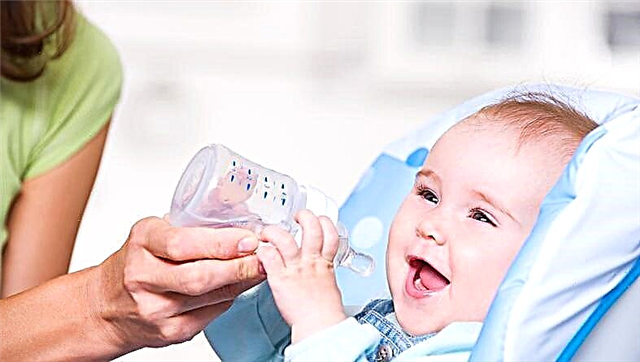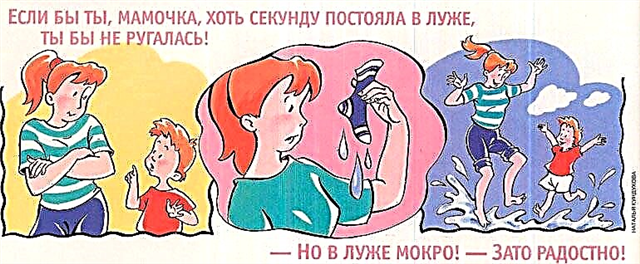
The development of a small child always touches his parents. When the baby confidently holds her head, the family is a real holiday. Naturally, mom and dad are anxiously waiting for the moment when the baby learns to regulate the position of the body - to turn from the abdomen to the back and vice versa. Whether it is necessary to teach the child to do this and how to master turns from the abdomen to the back, we will tell you in this article.

Norms and terms
Usually, at the very beginning, babies master turns from back to stomach, and only then it is time for a coup in the opposite direction. The average period of a coup from the back to the tummy is 3-4 months, respectively, from the position on the stomach, the child, on average, learns to roll onto the back at 4-5 months of life.
The norms were invented by someone unknown and when, and they cannot be considered the ultimate truth. Quite often, babies cannot master any coups by six months, or they turn at most to the side.
Parents should not panic if their five-month-old baby does not make body turns in space. He will definitely begin to do this when the muscle tissue and ligamentous apparatus are prepared for such movements.

All babies develop at a different pace, for each nature has provided an individual scheme for growing up, and therefore you should not be guided by any norms and advice from friends and relatives. Your child is only yours, he does not have to be like another kid. You cannot compare them.
If the child is "behind"
In no case should parents consider their child "lagging behind" if he does not want to roll from his stomach to his back at the moment. Such movements become possible if the muscles of the back, abdomen, lateral oblique muscles and ligaments are sufficiently developed. These muscles are gradually strengthened and stimulated, and this happens at different rates for all toddlers.
Agile, inquisitive and restless toddlers begin to roll over earlier, and children with a fair body weight, good appetite, a solid amount of laziness and a calm temperament can learn new motor skills later.

Children who were born prematurely, as well as children who were born from pregnancy accompanied by pathologies, fetal hypoxia develop more slowly and later master coups. Babies with congenital ailments, weak and sickly children will also master coups much later.
Much also depends on the incentive. If the child has it, coups will be mastered by him earlier. The main incentive for him is the desire to learn about this world in some additional way, not just lying on his back.
If you deal with the child, enthrall him with toys and bright objects that are interesting to him, the likelihood that he will turn earlier increases.


The opinion of Dr. Komarovsky
The well-known pediatrician Yevgeny Komarovsky quite often urges adults not to panic from scratch. In 99% of cases, if a child in his 4-5 months refuses to roll from his stomach to his back, there is not the slightest reason for worry and anxiety. If there are no other complaints, you should not suspect any pathology in the toddler.
A baby who eats normally, reacts emotionally to relatives, turns his head at the sound, tries to make sounds himself, but does not turn over, is healthy. It's just that it develops according to its own plan and schedule, which is not like the norms published on the Internet or lying in the form of a hint plate on the children's doctor's desk.
Therefore, the doctor recommends just waiting for a certain time. When the muscles of the crumbs are ready, it will definitely start to roll over. There are not so many diseases that interfere with the work of the musculoskeletal system, medicine is known, they are all severe - such as cerebral palsy or other lesions of the central nervous system. Parents usually learn about them even at the first examination or even from the neonatologist of the parental home where the baby was born.

If doctors have not found such ailments until this day, then worries about the absence of coups are unnecessary.
Komarovsky understands and accepts the desire of parents to help the baby to master new motor skills as soon as possible. The pediatrician recommends to start teaching or training the baby only when mom and dad have no endurance or desire to wait at all. But such training should in no way harm the child.
Komarovsky admits, although he does not consider it necessary, a strengthening massage, gymnastics aimed at strengthening the muscles of the back, neck, limbs and lateral muscles. However, Komarovsky does not recommend using jumpers and walkers, like other verticalizing devices. The baby's spine is not ready for such loads either at 3 months or at 6 months, and the desire of parents to do what is best can result in injury, severe consequences for the child's health in the future.
Intensive and aggressive massage, which will exhaust both mother and child, will not bring any benefit, but it will harm easily. If you want to teach your baby to roll over from stomach to back, Evgeny Olegovich recommends that parents not force the child to do it by force. If the muscles are not ready, no activity will give the little one an opportunity to master new movements.
Komarovsky believes that the most reasonable parental behavior in this situation is the creation of favorable conditions for development, and not a forced influence on the child's body.
Readiness for classes
Parents who are determined to teach their babies to roll over from belly to back should honestly answer themselves to the main question - is their little one ready for such activities. It is not so difficult to assess the degree of readiness, it is enough to note the existing skills:
- the child feels confident in the prone position, easily holds the head, knows how to turn it in the prone position towards the object or familiar voices;
- in a position on the stomach, the toddler can briefly lean on his elbows, trying to rise higher;
- in a position on the back, the baby can raise his legs, bring them to his face, grab them, and also tries to raise his head.
If you answered these questions in the affirmative, it means that the muscular system of the back, neck and abdomen is almost ready to join in a new process for them, you can do it. If the answer to at least one point is negative, wait another month and answer the questions again.
For exercising, you will need massage oil or baby cream, a gymnastic baby mat that can be laid on a hard and flat surface, such as the floor, and a fitball (optional).
Massage and gymnastics
Any parent or grandmother is able to master and carry out a general strengthening massage independently at home. It is in a familiar environment, when touched by relatives and already familiar hands, the child will feel as calm and relaxed as possible. There will be little sense from the massage that a professional massage therapist (that is, a complete stranger for the baby) does to a child screaming from stress.
Home massage will strengthen the contact between mother and child, make the procedure an interesting game, and also save a lot of money from the family budget, because massage is an expensive pleasure. Classes should be carried out only when the baby is healthy, he is well rested, not hungry. It is recommended to combine them with air baths - this will be of double benefit.
You can train twice a day, or once, it all depends on the mood of all participants in the process. If the child is out of sorts, there is no need to do gymnastics or massage at any cost. The exercises will be useful only if the baby is interested in the very process of the game started by the mother.
When carrying out the massage, pay attention to the strength of the pressure of the hands - the touch should be light, not causing pain. If the baby is uncomfortable, he will definitely let you know about this by shouting, listen to him and change the tactics of influence.
We list several effective techniques that are recommended to be applied no earlier than 3 months of age in order to master the coups from the abdomen to the back.
- "Circles and Arcs". This exercise should help strengthen your abs. With weak abs, flipping onto your back will be difficult. The child should lie on his back. In a circular motion, the mother easily strokes and massages the baby's abdomen clockwise - around the navel, expanding the circumference, and back. Then the thumbs should draw arcs from the navel to the ribs and from the navel to the groin area.
- "Strong back"... This technique is carried out by placing the child on his stomach. First, they lightly massage and stroke the back along the spine, and then make transverse tapping with your fingertips along the line of the ribs to the spinal column.
- "Caterpillar". This technique is used to strengthen the lateral and oblique muscles. When turning from the abdomen to the back, the baby rests on the handle, transferring the weight of the body to it, largely due to the work of the lateral muscles, the coup itself occurs on the back. It is necessary to place the child on his stomach and "stretch" him by raising his arms up. With light movements, the lateral muscles are massaged and stroked from the armpits to the knees or feet.
Do massage at home only with warm hands, the touch of cold palms will not be pleasant to the child, he will not be able to relax and trust you. Apply massage emollients. Increase the duration of the session gradually - from five minutes to 10-15 minutes. After a ten-day course, take a break for a couple of weeks.
Gymnastics should be daily. If it is repeated from day to day, the child gets used to it and takes it with great pleasure. The most effective belly-to-back flip exercises are as follows.
- "A bike". This exercise helps to strengthen the legs, lower back and lateral muscles of the baby. Lying on your back, bend the baby’s legs at the knees and make rhythmic movements with them, as if the baby is pedaling a bicycle. Such an alternating adduction of the legs will have a positive effect not only on muscle development, but also on digestion - the accumulation of intestinal gases will be unlikely.

- "Changeling". This exercise will help your child quickly master the flip itself. Put it on your tummy, carefully bring the opposite leg and turn the baby on its side, and then on the back. If the right leg is brought in, the child must be turned over to the left; if the left leg is brought in, the turn is to the right.


- "Sip". This exercise will require an interesting and bright toy, which is new and unfamiliar for the child, or another safe and interesting object. A child lying on his stomach sees a toy in front of him. Place it right in front of him, and make it so that the baby can reach and touch it. Then move the toy a little to the side and farther away so that the baby has to reach for it, straining the lateral and oblique muscles. Help him by creating a support under the feet with your palm, so the baby can push off and move forward. Gradually, the baby will begin to roll over to make it easier for him to reach an interesting object.


You can also develop your back, abdomen and sides, in order to eventually roll over from your abdomen to your back and back, using a fitball. But first you should consult with a pediatrician so as not to harm the baby.
You can practice additional swimming lessons. They are shown even to a newborn. You can teach your baby to swim in a large bath on your own, or you can use the experience and knowledge of professional trainers who can help the little one. To do this, you need to enroll with the baby in a special group for the smallest in the pool.


Tips & Tricks
Parents who work with a child in order to teach him the first coups need to be patient, not everything will work out right away. All exercises and massage techniques should be performed correctly, with strict adherence to the technique of their implementation.
Adults need to make sure that the muscles train symmetrically - from both sides, otherwise the baby may begin to roll over only on one side.
It often happens that a child who has already begun to roll over from a prone position on his back suddenly stops doing so. There is nothing pathological or unusual about this. Quite often, small children learn new skills fragmentarily, after a few days, believe me, the baby will definitely "remember" the acquired ability to change the position of the body in space and use it, but already consciously - when he has a good motive for that.
For information on how to teach a child to roll over, see the next video.



